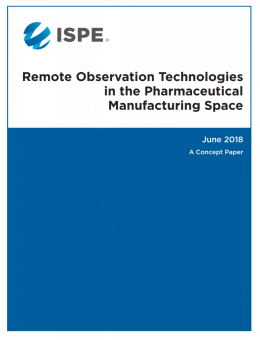Remote Observation Technologies in the Pharmaceutical Manufacturing Space
1 Introduction
Contemporary communications technologies, particularly those relating to the internet, have the potential to revolutionize pharmaceutical manufacturing practices. The judicious use of network communication tools may benefit manufacturing operations in a number of different ways. For example, mobile communications tools adapted for cleanroom use will empower remotely-located subject matter experts to assist staff on the factory floor in both training and troubleshooting. Remote access to real-time manufacturing system data can expedite maintenance procedures and has led to analytical tools (both local and cloud-based) appearing on the market for automated, preventive maintenance solutions. Network video products will compliment all these efforts; cameras embedded inside critical manufacturing processes can stream live video for use by staff located anywhere on a company’s global network. Some companies are embracing all of these concepts. This opinion piece is intended to explore these applications and how they relate to the pharmaceutical industry.
2 The Business Case for Pharmaceutical Manufacturing Connectivity
The pharmaceutical business is becoming increasingly global, with many established companies looking to expand into emerging geographical markets. In some cases, local policies and logistical considerations may require products to be manufactured within that territory. Inevitably this model predicts a proliferation in the number of manufacturing sites that larger firms will be required to operate. This may lead to smaller, localized manufacturing sites managed using an economically-appropriate workforce, which may deny them the full suite of engineering talent afforded to larger, global manufacturing sites.
By properly using network-based communication technologies, companies can better share their global expertise with these smaller operations. This approach offers business advantages in areas such as travel and productivity. First, international travel constitutes a major cost for global business. Improved communications tools can be correlated directly to a reduction in travel spending. Second, real-time network communications can expedite technical resolutions and reduce system downtime. Of course, these business arguments are not new. Nevertheless, contemporary and emerging virtual-presence solutions, particularly in the wearable technology space, have the potential to make international network-based collaboration more effective than ever.
Video communication does not have to be limited to peer-to-peer communication between staff members. Companies have begun integrating network cameras into manufacturing systems. In addition to the benefits outlined, cameras integrated onto the line can serve to elucidate areas within the system that may be hard to see or access during normal operation. The primary driver is to have live, streaming video available for supporting staff during maintenance and troubleshooting procedures. As an extension, however, there is the potential for using temporarily-stored video streams to retrospectively analyze and investigate adverse events. The compliance implications of this concept are discussed below.
As a corollary, all of these models can also be applied to the relationship between manufacturer and system vendor. Generally speaking, through an appropriate network security policy, companies could temporarily connect system vendors to machines hosted on the company’s network, thereby allowing direct support from the system experts.
Read more by downloading Remote Observation Technologies in the Pharmaceutical Manufacturing Space (Published: June 2018).
